
Raffaello Sanzio Raphael Painting Reproductions 2 of 5
1483-1520
Italian High Renaissance Painter
111 Raphael Paintings
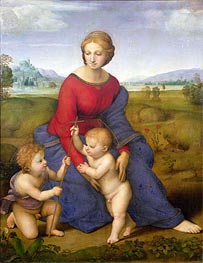
Madonna of Belvedere (Madonna del Prato) c.1505/06
Oil Painting
$2250
$2250
Canvas Print
$72.14
$72.14
SKU: RSA-2055
Raffaello Sanzio Raphael
Original Size: 113 x 88.5 cm
Kunsthistorisches Museum, Vienna, Austria
Raffaello Sanzio Raphael
Original Size: 113 x 88.5 cm
Kunsthistorisches Museum, Vienna, Austria
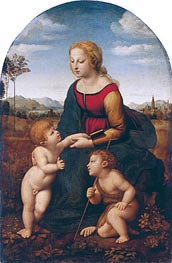
La Belle Jardiniere c.1507/08
Oil Painting
$2626
$2626
Canvas Print
$61.75
$61.75
SKU: RSA-2056
Raffaello Sanzio Raphael
Original Size: 122 x 80 cm
Louvre Museum, Paris, France
Raffaello Sanzio Raphael
Original Size: 122 x 80 cm
Louvre Museum, Paris, France
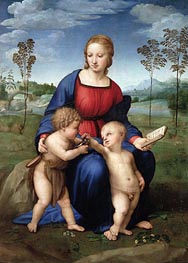
Madonna of the Goldfinch (Madonna del Cardellino) c.1506
Oil Painting
$2598
$2598
Canvas Print
$66.87
$66.87
SKU: RSA-2057
Raffaello Sanzio Raphael
Original Size: 107 x 77 cm
Galleria degli Uffizi, Florence, Italy
Raffaello Sanzio Raphael
Original Size: 107 x 77 cm
Galleria degli Uffizi, Florence, Italy
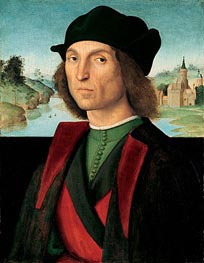
Portrait of a Man c.1502/04
Oil Painting
$1614
$1614
Canvas Print
$61.75
$61.75
SKU: RSA-4250
Raffaello Sanzio Raphael
Original Size: 47 x 37 cm
Liechtenstein Museum, Vienna, Austria
Raffaello Sanzio Raphael
Original Size: 47 x 37 cm
Liechtenstein Museum, Vienna, Austria
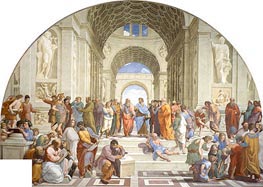
School of Athens c.1510/11
Oil Painting
$11959
$11959
Canvas Print
$66.53
$66.53
SKU: RSA-5563
Raffaello Sanzio Raphael
Original Size: 547 x 770 cm
Pinacoteca, Vatican, Vatican City
Raffaello Sanzio Raphael
Original Size: 547 x 770 cm
Pinacoteca, Vatican, Vatican City

The Three Graces c.1504/05
Oil Painting
$1281
$1281
Canvas Print
$61.75
$61.75
SKU: RSA-8483
Raffaello Sanzio Raphael
Original Size: 17.8 x 17.6 cm
Musee Conde, Chantilly, France
Raffaello Sanzio Raphael
Original Size: 17.8 x 17.6 cm
Musee Conde, Chantilly, France

Angels (detail from The Triumph of Galatea) c.1511
Oil Painting
$2543
$2543
SKU: RSA-9404
Raffaello Sanzio Raphael
Original Size: unknown
Villa Farnesina, Rome, Italy
Raffaello Sanzio Raphael
Original Size: unknown
Villa Farnesina, Rome, Italy
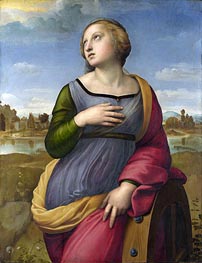
Saint Catherine of Alexandria c.1507
Oil Painting
$1711
$1711
Canvas Print
$88.33
$88.33
SKU: RSA-11279
Raffaello Sanzio Raphael
Original Size: 72.2 x 55.7 cm
National Gallery, London, UK
Raffaello Sanzio Raphael
Original Size: 72.2 x 55.7 cm
National Gallery, London, UK
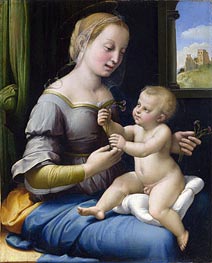
The Madonna of the Pinks (La Madonna dei Garofani) c.1506/07
Oil Painting
$1846
$1846
Canvas Print
$61.75
$61.75
SKU: RSA-11280
Raffaello Sanzio Raphael
Original Size: 27.9 x 22.4 cm
National Gallery, London, UK
Raffaello Sanzio Raphael
Original Size: 27.9 x 22.4 cm
National Gallery, London, UK

The Garvagh Madonna c.1509/10
Oil Painting
$1897
$1897
Canvas Print
$61.75
$61.75
SKU: RSA-11281
Raffaello Sanzio Raphael
Original Size: 38.9 x 32.9 cm
National Gallery, London, UK
Raffaello Sanzio Raphael
Original Size: 38.9 x 32.9 cm
National Gallery, London, UK
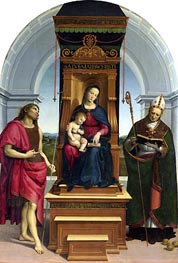
The Ansidei Madonna 1505
Oil Painting
$3803
$3803
Canvas Print
$105.44
$105.44
SKU: RSA-11282
Raffaello Sanzio Raphael
Original Size: 216.8 x 147.6 cm
National Gallery, London, UK
Raffaello Sanzio Raphael
Original Size: 216.8 x 147.6 cm
National Gallery, London, UK

An Allegory (Vision of a Knight) c.1504
Oil Painting
$1639
$1639
Canvas Print
$61.75
$61.75
SKU: RSA-11283
Raffaello Sanzio Raphael
Original Size: 17.1 x 17.3 cm
National Gallery, London, UK
Raffaello Sanzio Raphael
Original Size: 17.1 x 17.3 cm
National Gallery, London, UK

Portrait of Pope Julius II 1511
Oil Painting
$1863
$1863
Canvas Print
$84.74
$84.74
SKU: RSA-11284
Raffaello Sanzio Raphael
Original Size: 108.7 x 81 cm
National Gallery, London, UK
Raffaello Sanzio Raphael
Original Size: 108.7 x 81 cm
National Gallery, London, UK
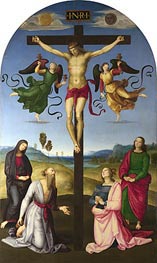
The Mond Crucifixion c.1502/03
Oil Painting
$6588
$6588
Canvas Print
$61.75
$61.75
SKU: RSA-11285
Raffaello Sanzio Raphael
Original Size: 283.3 x 167.3 cm
National Gallery, London, UK
Raffaello Sanzio Raphael
Original Size: 283.3 x 167.3 cm
National Gallery, London, UK
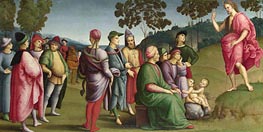
Saint John the Baptist Preaching 1505
Canvas Print
$61.75
$61.75
SKU: RSA-11286
Raffaello Sanzio Raphael
Original Size: 26.2 x 52 cm
National Gallery, London, UK
Raffaello Sanzio Raphael
Original Size: 26.2 x 52 cm
National Gallery, London, UK

The Procession to Calvary c.1504/05
Canvas Print
$61.75
$61.75
SKU: RSA-11287
Raffaello Sanzio Raphael
Original Size: 24.4 x 85.5 cm
National Gallery, London, UK
Raffaello Sanzio Raphael
Original Size: 24.4 x 85.5 cm
National Gallery, London, UK

The Madonna and Child (The Mackintosh Madonna) c.1509/11
Oil Painting
$1639
$1639
Canvas Print
$76.23
$76.23
SKU: RSA-11288
Raffaello Sanzio Raphael
Original Size: 78.8 x 64.2 cm
National Gallery, London, UK
Raffaello Sanzio Raphael
Original Size: 78.8 x 64.2 cm
National Gallery, London, UK

The Madonna and Child n.d.
Oil Painting
$2118
$2118
Canvas Print
$109.17
$109.17
SKU: RSA-11289
Raffaello Sanzio Raphael
Original Size: 87 x 61.3 cm
National Gallery, London, UK
Raffaello Sanzio Raphael
Original Size: 87 x 61.3 cm
National Gallery, London, UK

The Deposition 1507
Oil Painting
$9063
$9063
Canvas Print
$90.35
$90.35
SKU: RSA-11290
Raffaello Sanzio Raphael
Original Size: 184 x 176 cm
Galleria Borghese, Rome, Italy
Raffaello Sanzio Raphael
Original Size: 184 x 176 cm
Galleria Borghese, Rome, Italy
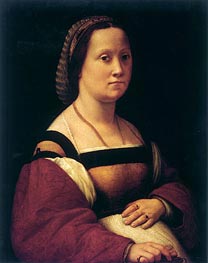
La Donna Gravida (The Pregnant Woman) c.1505/07
Oil Painting
$1673
$1673
Canvas Print
$106.17
$106.17
SKU: RSA-11291
Raffaello Sanzio Raphael
Original Size: 66 x 52 cm
Palazzo Pitti, Florence, Italy
Raffaello Sanzio Raphael
Original Size: 66 x 52 cm
Palazzo Pitti, Florence, Italy

Madonna Colonna c.1507/08
Oil Painting
$1976
$1976
Canvas Print
$61.75
$61.75
SKU: RSA-11292
Raffaello Sanzio Raphael
Original Size: 52 x 38 cm
Gemaldegalerie, Berlin, Germany
Raffaello Sanzio Raphael
Original Size: 52 x 38 cm
Gemaldegalerie, Berlin, Germany

Madonna of the Candelabra c.1513
Oil Painting
$2309
$2309
Canvas Print
$91.21
$91.21
SKU: RSA-11293
Raffaello Sanzio Raphael
Original Size: 65.7 x 64 cm
The Walters Art Museum, Baltimore, USA
Raffaello Sanzio Raphael
Original Size: 65.7 x 64 cm
The Walters Art Museum, Baltimore, USA
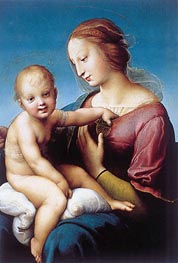
Niccolini-Cowper Madonna 1508
Oil Painting
$2005
$2005
Canvas Print
$65.85
$65.85
SKU: RSA-11294
Raffaello Sanzio Raphael
Original Size: 80.7 x 57.5 cm
National Gallery of Art, Washington, USA
Raffaello Sanzio Raphael
Original Size: 80.7 x 57.5 cm
National Gallery of Art, Washington, USA
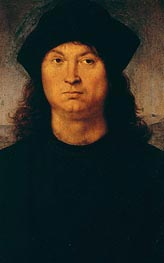
Portrait of a Man c.1502
Oil Painting
$1307
$1307
Canvas Print
$61.75
$61.75
SKU: RSA-11295
Raffaello Sanzio Raphael
Original Size: 45 x 31 cm
Galleria Borghese, Rome, Italy
Raffaello Sanzio Raphael
Original Size: 45 x 31 cm
Galleria Borghese, Rome, Italy